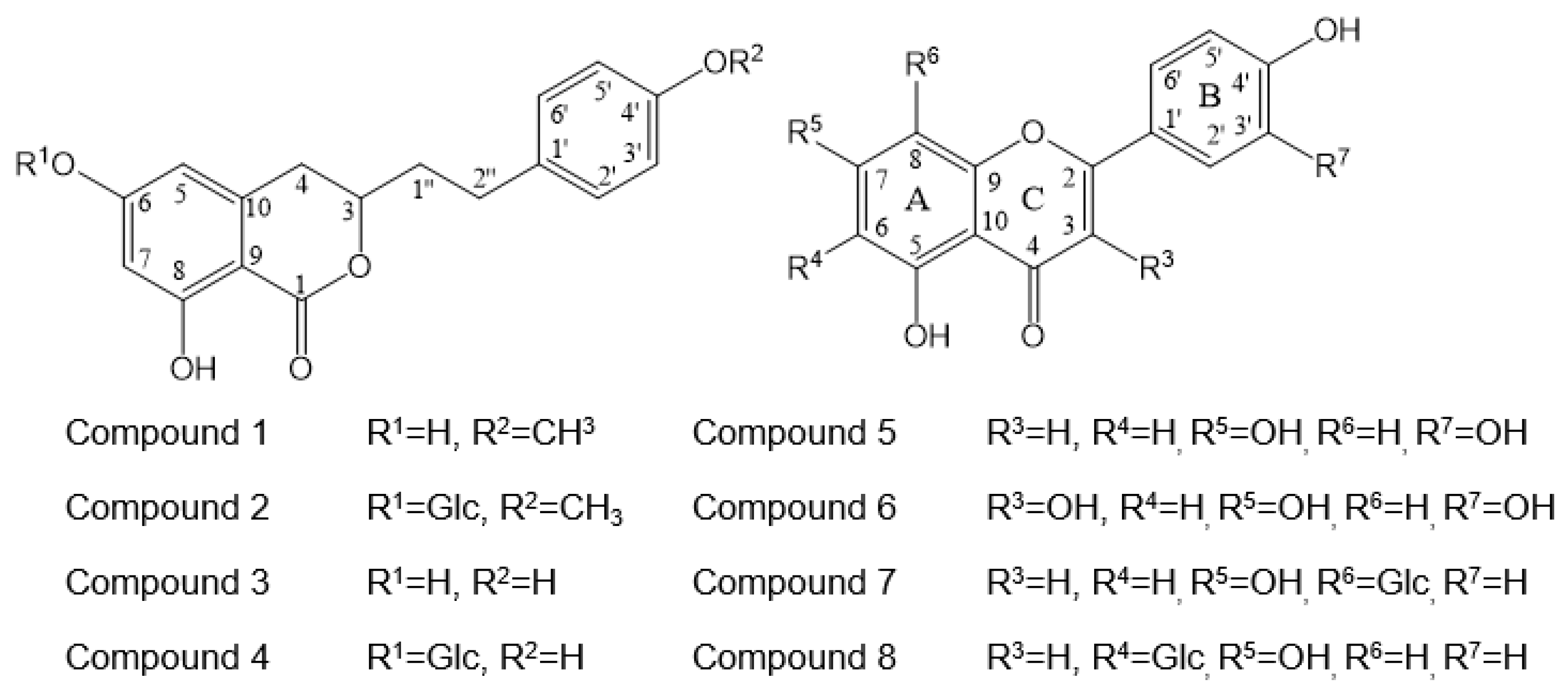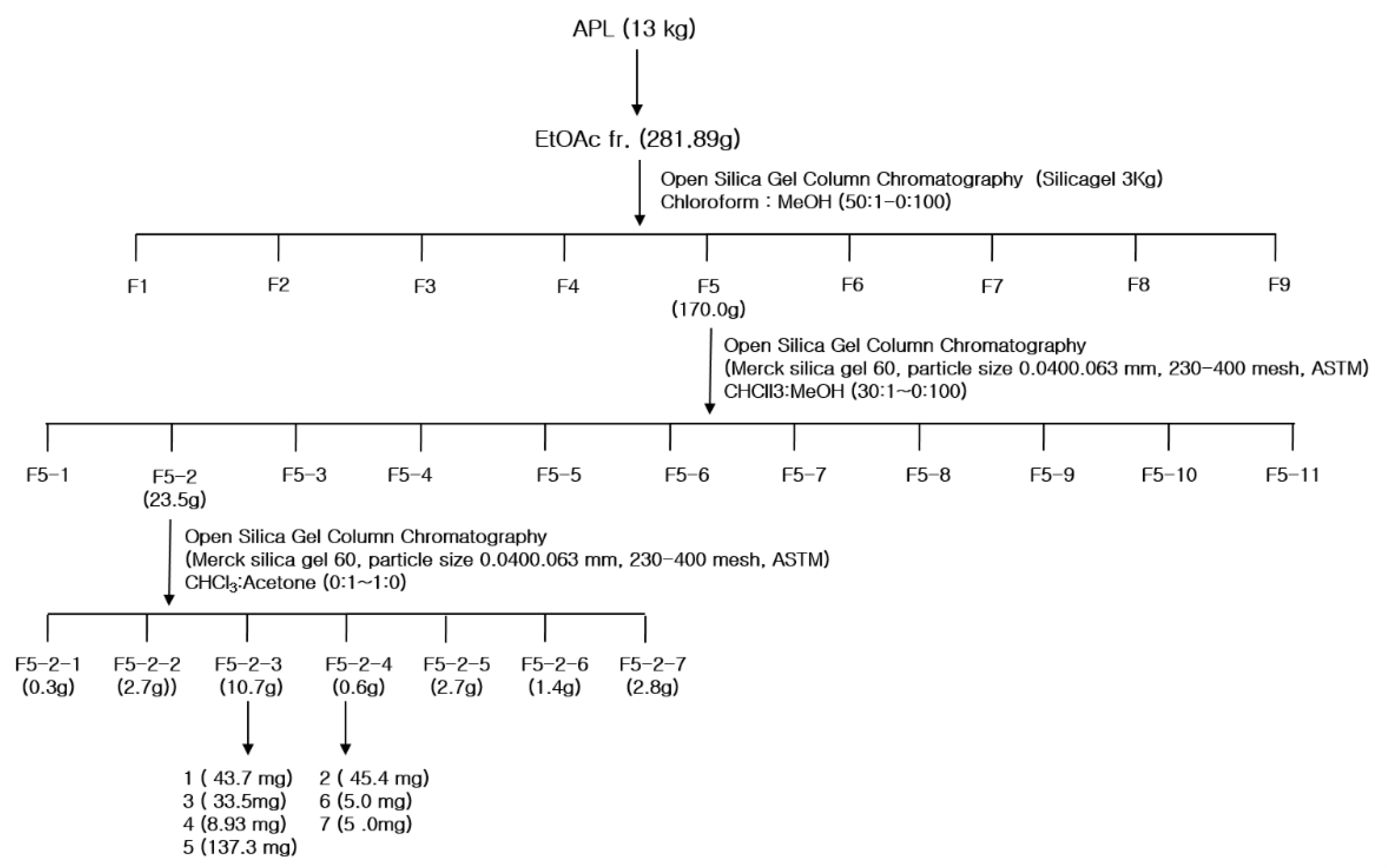Isolation of Isocoumarins and Flavonoids as α-Glucosidase Inhibitors from Agrimonia pilosa L.
Abstract
1. Introduction
2. Results and Discussion
2.1. Isolation of Active Compounds from AP
2.2. Structure Elucidation of Active Compounds from AP
2.3. AGI Activities of the Compounds Isolated from AP
2.4. AGI Kinetic Analysis of Active Isocoumarins
3. Materials and Methods
3.1. AGI Activity Guided Fractionation and Isolation
3.2. Agrimonolide (1)
3.3. Agrimonolide-O-β-d-glucopyranoside (2)
3.4. Desmethylagrimonolide (3)
3.5. Desmethylagcimonolide-O-β-d-glucopyranoside (4)
3.6. Luteolin (5)
3.7. Quercetin (6)
3.8. Vitexin (7)
3.9. Isovitexin (8)
3.10. Alpha-Glucosidase Inhibition (AGI) Assay
3.11. AGI Kinetic Analysis
3.12. HPLC Analysis
3.13. NMR Analysis
3.14. Statistical Analysis
4. Conclusions
Supplementary Materials
Author Contributions
Funding
Conflicts of Interest
References
- Harding, J.L.; Pavkov, M.E.; Magliano, D.J.; Shaw, J.E.; Gregg, E.W. Global trends in diabetes complications: A review of current evidence. Diabetologia 2019, 62, 3–16. [Google Scholar] [CrossRef] [PubMed]
- Guariguata, L.; Whiting, D.R.; Hambleton, I.; Beagley, J.; Linnenkamp, U.; Shaw, J.E. Global estimates of diabetes prevalence for 2013 and projections for 2035. Diabetes Res. Clin. Pract. 2014, 103, 137–149. [Google Scholar] [CrossRef] [PubMed]
- Tundis, R.; Loizzo, M.R.; Menichini, F. Natural products as alpha-amylase and alpha-glucosidase inhibitors and their hypoglycaemic potential in the treatment of diabetes: An update. Mini-Rev. Med. Chem. 2010, 10, 315–331. [Google Scholar] [CrossRef] [PubMed]
- Shori, A.B. Screening of antidiabetic and antioxidant activities of medicinal plants. J. Integr. Med. 2015, 13, 297–305. [Google Scholar] [CrossRef]
- Trojan-Rodrigues, M.; Alves, T.L.S.; Soares, G.L.G.; Ritter, M.R. Plants used as antidiabetics in popular medicine in Rio Grande do Sul, southern Brazil. J. Ethnopharmacol. 2012, 139, 155–163. [Google Scholar] [CrossRef]
- Koshiura, R.; Miyamoto, K.; Ikeya, Y.; Taguchi, H. Antitumor activity of methanol extract from roots of Agrimonia pilosa Ledeb. Jpn. J. Pharmacol. 1985, 38, 9–16. [Google Scholar] [CrossRef]
- Miyamoto, K.; Kishi, N.; Koshiura, R. Antitumor effect of agrimoniin, a tannin of Agrimonia pilosa Ledeb., on transplantable rodent tumors. Jpn. J. Pharmacol. 1987, 43, 187–195. [Google Scholar] [CrossRef]
- Zhu, L.; Tan, J.; Wang, B.; He, R.; Liu, Y.; Zheng, C. Antioxidant activities of aqueous extract from Agrimonia pilosa Ledeb and its fractions. Chem. Biodivers. 2009, 6, 1716–1726. [Google Scholar] [CrossRef]
- Park, E.J.; Oh, H.; Kang, T.H.; Sohn, D.H.; Kim, Y.C. An isocoumarin with hepatoprotective activity in Hep G2 and primary hepatocytes from Agrimonia pilosa. Arch. Pharm. Res. 2004, 27, 944–946. [Google Scholar] [CrossRef]
- Liu, X.; Zhu, L.; Tan, J.; Zhou, X.; Xiao, L.; Yang, X.; Wang, B. Glucosidase inhibitory activity and antioxidant activity of flavonoid compound and triterpenoid compound from Agrimonia Pilosa Ledeb. BMC Complement. Altern. Med. 2014, 14, 12. [Google Scholar] [CrossRef]
- Na, B.; Nguyen, P.H.; Zhao, B.T.; Vo, Q.H.; Min, B.S.; Woo, M.H. Protein tyrosine phosphatase 1B (PTP1B) inhibitory activity and glucosidase inhibitory activity of compounds isolated from Agrimonia pilosa. Pharm. Biol. 2016, 54, 474–480. [Google Scholar] [CrossRef] [PubMed]
- Kato, H.; Li, W.; Koike, M.; Wang, Y.; Koike, K. Phenolic glycosides from Agrimonia pilosa. Phytochem. 2010, 71, 1925–1929. [Google Scholar] [CrossRef]
- Pan, Y.; Liu, H.X.; Zhuang, Y.L.; Ding, L.Q.; Chen, L.X.; Qiu, F. Studies on isolation and identification of flavonoids in herbs of Agrimonia pilosa. Zhongguo Zhong Yao Za Zhi 2008, 33, 2925–2928. [Google Scholar]
- Jung, M.; Park, M. Acetylcholinesterase inhibition by flavonoids from Agrimonia pilosa. Molecules 2007, 12, 2130–2139. [Google Scholar] [CrossRef] [PubMed]
- Gou, S.H.; Liu, J.; He, M.; Qiang, Y.; Ni, J.M. Quantification and bio-assay of alpha-glucosidase inhibitors from the roots of Glycyrrhiza uralensis Fisch. Nat. Prod. Res. 2016, 30, 2130–2134. [Google Scholar] [CrossRef] [PubMed]
- Tadera, K.; Minami, Y.; Takamatsu, K.; Matsuoka, T. Inhibition of alpha-glucosidase and alpha-amylase by flavonoids. J. Nutr. Sci. Vitaminol. 2006, 52, 149–153. [Google Scholar] [CrossRef]
- Şöhretoğlu, D.; Suat, S. Flavonoids as alpha-glucosidase inhibitors: Mechanistic approaches merged with enzyme kinetics and molecular modelling. Phytochem. 2019, 1–12. [Google Scholar] [CrossRef]
- Vinayagam, R.; Xu, B. Antidiabetic properties of dietary flavonoids: A cellular mechanism review. Nutr. Metab. 2015, 12, 60. [Google Scholar] [CrossRef]
- Xiao, Z.; Chen, S.; Cai, R.; Lin, S.; Hong, K.; She, Z. New furoisocoumarins and isocoumarins from the mangrove endophytic fungus Aspergillus sp. 085242. Beilstein J. Org. Chem. 2016, 12, 2077–2085. [Google Scholar] [CrossRef]
- Proenca, C.; Freitas, M.; Ribeiro, D.; Oliveira, E.F.T.; Sousa, J.L.C.; Tome, S.M.; Ramos, M.J.; Silva, A.M.S.; Fernandes, P.A.; Fernandes, E. alpha-Glucosidase inhibition by flavonoids: An in vitro and in silico structure-activity relationship study. J. Enzyme Inhib. Med. Chem. 2017, 32, 1216–1228. [Google Scholar] [CrossRef]
- Kwon, Y.I.; Apostolidis, E.; Shetty, K. In vitro studies of eggplant (Solanum melongena) phenolics as inhibitors of key enzymes relevant for type 2 diabetes and hypertension. Bioresour. Technol. 2008, 99, 2981–2988. [Google Scholar] [CrossRef] [PubMed]
Sample Availability: Samples of the compounds are available from the corresponding author on reasonable request. |




| Extract/Fraction | IC50 (µg/mL) | Fr. | IC50 (µg/mL) | Sub-Fr. | IC50 (µg/mL) | Sub-Fr. | IC50 (µg/mL) |
|---|---|---|---|---|---|---|---|
| Methanol | 47.7 ± 3.2 | F1 | 330 ± 0.2 | F5-1 | 15.5 ± 1.6 | F5-2-1 | 51.0 ± 6.1 |
| Hexane | 60.7 ± 4.1 | F2 | 62.3 ± 2.4 | F5-2 | 4.0 ± 2.6 | F5-2-2 | 28.5 ± 2.6 |
| Ethyl acetate | 18.8 ± 2.5 | F3 | 51.3 ± 3.3 | F5-3 | 46.3 ± 3.6 | F5-2-3 | 7.5 ± 3.6 |
| n-Buthanol | 29.8 ± 2.7 | F4 | 23.3 ± 0.9 | F5-4 | >100 | F5-2-4 | 13.3 ± 4.6 |
| F5 | 19.2 ± 8.4 | F5-5 | >100 | F5-2-5 | >100 | ||
| F6 | 34.9 ± 6.1 | F5-6 | 87.5 ± 6.6 | F5-2-6 | >100 | ||
| F7 | 70.0 ± 1.8 | F5-7 | 96.9 ± 7.6 | F5-2-7 | >100 | ||
| F8 | 67.0 ± 6.4 | F5-8 | >100 | - | - | ||
| F9 | 70.5 ± 2.6 | F5-9 | >100 | - | - | ||
| - | - | F5-10 | 97.1 ± 10.6 | - | - | ||
| - | - | F5-11 | 61.3 ± 6.4 | - | - |
| Number/Compound. | IC50 (µM) a | Inhibition Mode | KI (µM) b |
|---|---|---|---|
| 1 | 37.4 ± 0.4 | Non-competitive | 17.3 ± 0.6 |
| 2 | 71.6 ± 0.4 | NT c | 35.3 ± 1.2 |
| 3 | 24.2 ± 0.6 | Non-competitive | 11.6 ± 0.4 |
| 4 | 52.3 ± 1.8 | NT | 26.2 ± 0.6 |
| 5 | 65.8 ± 1.9 | NT, | 33.1 ± 1.4 |
| 6 | 28.7 ± 1.2 | Competitive [19] | 13.9 ± 0.8 |
| 7 | 117.6 ± 3.6 | NT | 57.6 ± 1.4 |
| 8 | 46.3 ± 1.7 | NT | 23.2 ± 0.8 |
| Acarbose d | 45.2 ± 1.2 | Competitive [19] | 22.5 ± 1.2 |
© 2020 by the authors. Licensee MDPI, Basel, Switzerland. This article is an open access article distributed under the terms and conditions of the Creative Commons Attribution (CC BY) license (http://creativecommons.org/licenses/by/4.0/).
Share and Cite
Park, M.J.; Kang, Y.-H. Isolation of Isocoumarins and Flavonoids as α-Glucosidase Inhibitors from Agrimonia pilosa L. Molecules 2020, 25, 2572. https://doi.org/10.3390/molecules25112572
Park MJ, Kang Y-H. Isolation of Isocoumarins and Flavonoids as α-Glucosidase Inhibitors from Agrimonia pilosa L. Molecules. 2020; 25(11):2572. https://doi.org/10.3390/molecules25112572
Chicago/Turabian StylePark, Mi Jin, and Young-Hwa Kang. 2020. "Isolation of Isocoumarins and Flavonoids as α-Glucosidase Inhibitors from Agrimonia pilosa L." Molecules 25, no. 11: 2572. https://doi.org/10.3390/molecules25112572
APA StylePark, M. J., & Kang, Y.-H. (2020). Isolation of Isocoumarins and Flavonoids as α-Glucosidase Inhibitors from Agrimonia pilosa L. Molecules, 25(11), 2572. https://doi.org/10.3390/molecules25112572





